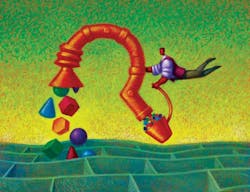Faster, Cheaper, Smaller Stimulates Better Data Acquisition
Nov. 1, 2010
4 min read
But in the past six months or so, he hasn't seen "huge changes" in the speed that his end-users need. Nor has reliability "changed dramatically," he remarks. Ben Orchard also hasn't seen any recent major or significant advances in speed, accuracy and reliability. But what this applications engineer with Opto 22 (www.opto22.com), a Temecula, Calif.-based automation vendor, does see is "the usual general trend: ‘faster, smaller, lower power.' " However, he emphasizes, "We've not heard a lot of requests for faster speeds—we've not heard people clamoring for ‘faster, faster, faster.' "Orchard notes that some faster-smaller devices might be more fragile. However, while ‘cheap and flimsy' sometimes wins the day with commercial, it does not with industrial users, he states. "They demand robustness. They want to purchase the device once and have it be bullet-proof."Austin, Texas-based test-and-automation supplier National Instruments Corp. (NI, www.ni.com), has been working hard to advance DAQ speed, reliability and accuracy. In August, the company made some under-the-hood changes with LabView 2010, notes Sam Freed, a DAQ product manager. "We boosted its speed by up to 20 percent." The company also increased accuracy and speed of its SC Express family's modules for strain and pressure sensors for bridge-based measurements, notes Elizabeth Smith, also a DAQ product manager. "We've removed the dependence on [measuring] the excitation voltage and also increased the sample rate to 102 kilosamples per second."Smith indicates that NI also sees "a lot of interest for high-channel thermal measurement, on thermal chambers for testing other devices." One solution that NI developed is a one-channel sampling device specifically for thermocouples, notes Freed. "The readings aren't particularly fast, but what we improved is the time to get to a first measurement. You use flash memory on the DAQ—and as soon as you plug it in, your computer launches a view window." The feedback mimics that of a handheld instrument, he adds.Industry also appears to be signaling a need for better energy monitoring, observes Arun Sinha, Opto 22's director of business development. What's behind that, he says, is the growing energy awareness in industry and among consumers. But because this awareness crosses into commercial sectors, "we think there's a growing need for a traditional DAQ provider to provide something for energy needs." And because there may be non-automation end-users in commercial businesses, DAQ devices must be "friendly" to those people "who don't know how to program a PLC (programmable logic controller)."Sinha explains that a new concept emerges in energy management: an "energy event." He believes that the cost of energy is more significant than many other costs combined, such as labor, raw materials and even information technology. So using DAQ will give end-users information on such events to allow operating decisions with energy awareness—and that will help them cut costs, he remarks.Linux useThere's also "lots of interest" in Linux or real-time operating systems (RTOSs), Judd suggests. Two that he mentions are QNX from QNX Software (www.qnx.com), Ottawa, Ontario, Canada; and VxWorks from Wind River Software (www.windriver.com), in Alameda, Calif. These now challenge Microsoft Corp., the Redmond, Wash., software giant. "In the control world, [Microsoft] Windows has always been burdened by going off and doing its ‘own things'—updates or memory check, who knows?—whereas the Linux and real-time guys stay focused on DAQ." Thus, uninterrupted DAQ creates the attraction, because the time buffer works against using Microsoft, he adds.That makes sense, just as "faster-cheaper-smaller" and/or lower power do. But Orchard cautions, "It's easy to get caught up with ‘faster, faster, faster.' " And worth remembering, Arun adds, is that it's not always good to "jump to control," especially if potential end-users know little about controls. As he notes, DAQ may provide "tremendous savings" by helping change companies' operating behaviors.C. Kenna Amos, [email protected], is an Automation World Contributing Editor.United Electronic Industries Inc.www.ueidaq.comOpto 22www.opto22.comNational Instruments Corp., NIwww.ni.comQNX Softwarewww.qnx.comWind River Softwarewww.windriver.com
Subscribe to Automation World's RSS Feeds for Columns & Departments
About the Author
C. Kenna Amos
Contributing Editor
Sign up for our eNewsletters
Get the latest news and updates

Leaders relevant to this article:
